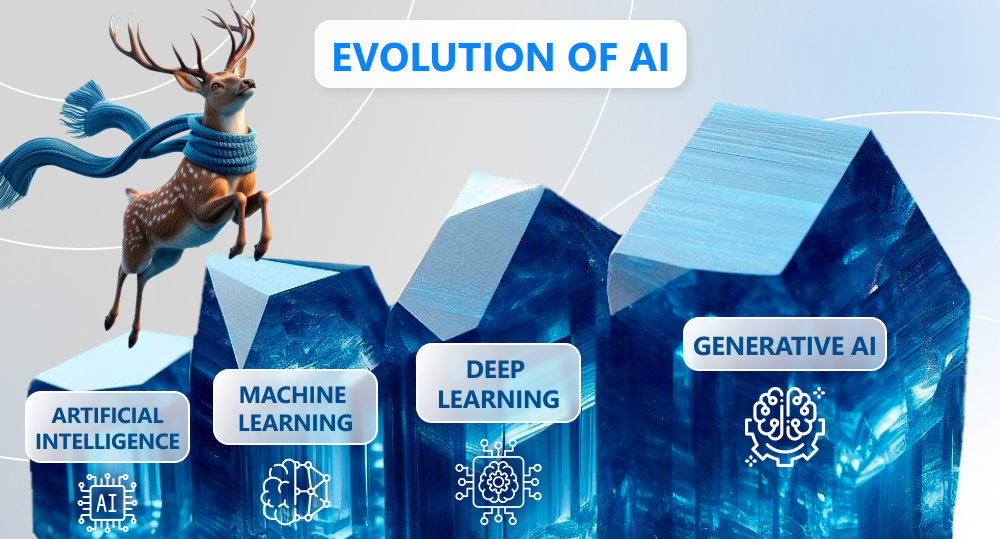By using generative AI in eCommerce platforms, you can easily create enjoyable digital experiences that feel real and boost customer loyalty. This is vital in our post-pandemic world, where users keep shifting towards online shopping but still crave an outside perspective and advice. Striving to stay ahead of the curve and meet these demands, renowned eCommerce giants like Amazon, Shopify, and Walmart have already integrated GenAI into their solutions.
Keep reading to find out how exactly artificial intelligence helps them enhance the service and gain insights into the hidden capabilities of this powerful technology in the e-commerce landscape.
written by:
Alexey Sliborsky
Solution Architect
By using generative AI in eCommerce platforms, you can easily create enjoyable digital experiences that feel real and boost customer loyalty. This is vital in our post-pandemic world, where users keep shifting towards online shopping but still crave an outside perspective and advice. Striving to stay ahead of the curve and meet these demands, renowned eCommerce giants like Amazon, Shopify, and Walmart have already integrated GenAI into their solutions.
Contents
GenAI in a Nutshell
GenAI is definitely the No.1 buzzword of the past two years, as people from most walks of life and business seem to have it at the tip of their tongues.
However, while some users play with the technology to create quaint images and academic essays, forward-looking entrepreneurs and quick-witted workers try to find new ways to make generative AI algorithms work for the good of operational processes and their business growth. This fact is also proved by statistics indicating that about 29% of Gen Z, 28% of Gen X, and 27% of Millennial employees in the USA already leverage generative AI tools to streamline their workflows.
But how exactly does this state-of-the-art technology work?
Having natural language processing and machine learning at its core, a generative AI model is trained on vast amounts of quality data to predict further elements in a sequence. To make algorithms produce totally new texts and images or implement natural language generation, the training data gets transformed into vectors via an embedding model. Also, such techniques as Generative Adversarial Networks (GANs) and Variational Autoencoders (VAEs) are employed.
As a result, when you enter the query, algorithms detect relevant keywords in their knowledge base and generate a response.
7 Reasons to Use AI in e-Commerce
With generative AI, you can handle plenty of tasks in a breeze, including those related to the e-commerce industry. Below, we explain how to apply the technology to your business to derive the maximum operational efficiency.
#1. Enhancing Customer Experiences
The research by Salesforce suggests that 65% of online shopping fans put personalized experiences at the top of their demands. The desire to promptly get a curated selection of relevant items and make quick decisions is absolutely fair in today's hectic world, where time is of the essence.
New-age e-Commerce AI tools allow online businesses to meet such needs and boost customer satisfaction. By thoroughly analyzing customer behavior and historical sales data, almighty algorithms predict possible further purchases, optimize store layouts, and deliver personalized offers at a fitter moment.
#2. Precise Customer Profiles
Also, proactive sellers may employ eCommerce generative AI tools to get a clear picture of their customer pools. Unlike traditional artificial intelligence, GenAI is capable of creating more detailed and structured client profiles based on existing data patterns at a significantly fast rate. Armed with such information, e-commerce businesses can increase customer engagement and elaborate effective abandoned cart recovery strategies.
#3. Effective Dynamic Pricing
The ability to offer digital buyers goods and services at a reasonable price without underselling is vital for the e-commerce players who want to keep their business operations afloat. At this point, generative AI capabilities also come in handy. By extracting valuable information (e.g., historical market trends, competitors' offers, current demand, and customer preferences) with RAG technology, omnipresent algorithms empower dynamic pricing strategies with the latest quality insights and let sellers boost their revenues.
#4. Advanced Virtual Interactions
Online shopping is not the fruit of the Covid-19 pandemic, it has been around for several decades. But it's only recently that it has managed to ensure the experience so similar to the real-life buying process. For certain reasons, this is the merit of generative AI commerce tools.
First of all, large language models have given impetus to creating virtual assistants capable of maintaining human-like customized conversations (taking the place of traditional chatbots that provide memorized answers limited by pre-trained scripts). Secondly, by enriching Augmented Reality/Virtual Reality with GenAI, it has become possible to integrate virtual fitting rooms into e-commerce websites and enable buyers to try the desired clothing items on without leaving the house.
By the way, Qulix has vast expertise in LLM-chatbot development. Tap here to learn what else our seasoned developers can do for your eCommerce project.
#5. Cost-Friendly Content Creation
This is the most evident way of using generative AI in e-Commerce, and it’s gaining popularity at a slapping pace. Hardly anyone will be surprised by the fact that Amazon already takes advantage of the technology to generate product descriptions and listings and streamline seller management. So why not follow its lead and entrust the creation of marketing messages, taglines, ads, SMM posts, images, or even an AI-generated eCommerce website to artificial intelligence?
#6. Optimized Storage
Also, generative AI in eCommerce targets inventory management. By generating detailed infographics and reports based on historical trends and customer data, the algorithms help online sellers analyze seasonal demand and preferences and a sales potential of a particular item. These insights can be used for warehouse layout optimization. By providing GenAI chatbots with access to warehouse storage systems, you can enable them to timely inform customers about sold-out products.
#7. Streamlined Logistics and Shipment
Supply chain management is another field that generative AI can enhance. Although at the moment, the technology only makes its first steps in this direction, e-commerce leaders repose trust in it. For instance, it is considered that in the not-too-distant future, GenAI will provide buyers with granular order tracking and generate optimal logistic networks and last-mile routes, taking into account real-time conditions (e.g., weather, traffic, priority deliveries, current locations).
Generative AI eCommerce Tools
As you see, GenAI has great potential to profoundly reshape the e-commerce world. To make sure of that and put the technology through its paces, just take advantage of one of the tools listed below.
Tool
Capabilities
Veesual
With Veesual, you can let users try clothing items on in a digital space by creating virtual fitting-room experiences.
Cresta
The tool helps to boost customer-chatbot conversations in support centers.
Shopify Magic
A back-office virtual assistant that simplifies task generation and management for vendors, aides in customer support, and generates content.
Phrasee
An AI-powered platform that allows for quick market message generation and SMM content creation.
Jasper
A multifunctional e-commerce tool capable of implementing a wide range of tasks: from text/image generation to advanced analytics.
GenAI Challenges
Generative AI is the new black for today's tech-based businesses, and the trend is likely to evolve. According to recent statistics, its global market size is forecasted to beat $118.06 billion by 2032. However, the technology requires significant adjustments, as it's still at the dawn of its development. Here are the challenges you have to keep in mind before embedding GenAI into your eCommerce business:
- Algorithms learn from multiple data sources, including those protected by copyright, which means you can unintentionally violate intellectual property rights when using AI-generated content without double-checking;
- Generated content is sometimes ethically biased;
- The models' knowledge base has the cut-off date, and that is one of the reasons it produces misleading or outdated responses;
- Some customer groups treat GenAI with suspicion or even fear, and the fact that your online store employs AI may scare them off;
- Generated responses are prone to hallucinations and still require supervision and control;
- The information produced during conversations with customers (especially dialogues containing personal details) needs additional security measures to avoid data leakages or malicious use.
Thoughts to Go
Luckily, none of these obstacles can prevent the brightest tech minds from dreaming and planning. Trying to surmount the challenges, they keep looking for innovative ideas and GenAI use cases.
Their nearest goals for the e-commerce sector encompass AI-boosted voice assistants, new item feasibility testing tools, super-personalized content delivery, AR/VR buying experiences, advanced supply chain management, biased customer feedback identification, cyber risk detection, and other bold concepts. And who knows, maybe the algorithm-infused shopping is much closer than it seems.
Ready to enrich your e-commerce solution with generative AI and don't know where to start? Contact us, and we will analyze the current state of your software to define the best-fit digital transformation strategy.
Valuable Insights
When artificial intelligence employs generative models to create high-quality images, texts, or other content, we are witnessing generative AI in action. This is achieved through the ongoing training of algorithms and their enhancement. ChatGPT is the most illustrious example of the solution built with the technology.
Traditional AI is the technology various businesses have been employing for over a decade. Such intelligence is based on ML models and is built on pre-defined rules to implement specific tasks. By analyzing vast amounts of input data, it makes conclusions and predictions and, therefore, is an indispensable component of recommendation engines and conversational AI bots.
The mission of generative AI, on the other hand, consists in new content creation. With the help of its training data, the technology produces one-of-a-kind images, texts, and videos as a response to a user's prompt.
These are the key generative AI language models:
- Recurrent neural networks (by analyzing the previous elements of natural language utterances and time-stamped data, these models can predict further elements);
- Autoregressive models (capable of predicting the distribution of further elements, if they are provided with the previous context);
- Generative Adversarial Networks (having two key elements at their core — a discriminator that detects real and fake data and a generator that creates images, texts, and sounds — these models produce highly realistic and coherent content);
- Transformer-based models (by defining the relationships between all the elements in a sequence with attention mechanisms, the models adjust these elements for content generation);
- Variational Autoencoders (these models, used for data encoding and decoding, make new content creation possible through learning the input data representations).
An LLM is an advanced model based on deep learning, pre-trained on huge amounts of data, and capable of processing and producing consistent texts.
By taking the best of both worlds, AI eCom represents the new-age approach to online shopping and selling. Truly personalized recommendations, advanced chatbots, optimized inventory management, and virtual try-ons — these are just several out of many innovations unlocked by the combination of generative AI and eCommerce.
Here is the list of the most popular generative AI use cases in eCommerce:
- Customer data analytics tools;
- Personalized content and recommendations;
- Customized product descriptions;
- Image generation;
- Unique social media posts, ads, and marketing campaigns;
- Efficient supply chain management;
- Chatbot consulting;
- Virtual customer experience.
With breakthrough AI e-commerce tools, retailers can easily create a fully-fledged profile based on purchase history, browsing behavior, and the latest preferences of each particular buyer. Later, they can employ these insights to deliver personalized experiences and build enjoyable seller-customer interactions.
Various retail companies across the globe make use of generative AI technology. For instance, Walmart employs a GenAI-powered chatbot to negotiate prices with its suppliers, Carrefour has a solution that generates personalized suggestions, and Mercari has launched a virtual assistant that non-intrusively guides customers to the most tempting goods.
When integrating generative AI-powered solutions into your online store, keep in mind the following AI eCommerce business rules:
- Differentiate AI-generated content and human additions, as the latter can be subject to copyright;
- When using generative AI for eCommerce purposes, pay attention to the terms and policies of each particular tool;
- When communicating with AI solutions, try to input original prompts to boost content uniqueness;
- Don't add trademarks and logos to your prompt to avoid distorted outputs;
- Try to avoid confidential or personal information when creating a query (especially if it belongs to a third party) to prevent data leakages.
Although GenAI significantly extends the capabilities of the e-commerce sector, it is still in its early adoption phase, and therefore, requires further development. Among the most vivid challenges it brings to eCommerce businesses are misleading content generation, necessity for human double-checking, intellectual rights issues, and ethical bias.
Such eCommerce giants as eBay, Amazon, Shopify, Etsy, and Alibaba Group head the list of generative AI trailblazers.
Despite their huge potential, AI technologies require significant enhancements. Since large language models can't think, as many users mistakenly believe, they are limited by pre-defined scripts, fail to build coherent responses offhand, and need further training. Also, wide customer groups are still not ready to make use of AI features during their buying journeys due to the lack of awareness and security concerns.
Here are the four major types of eCommerce presence:
- Business-to-Business (B2B);
- Consumer-to-Business (C2B);
- Business-to-Consumer (B2C);
- Consumer-to-Consumer (C2C).

Contacts
Feel free to get in touch with us! Use this contact form for an ASAP response.
Call us at +44 151 528 8015
E-mail us at request@qulix.com










